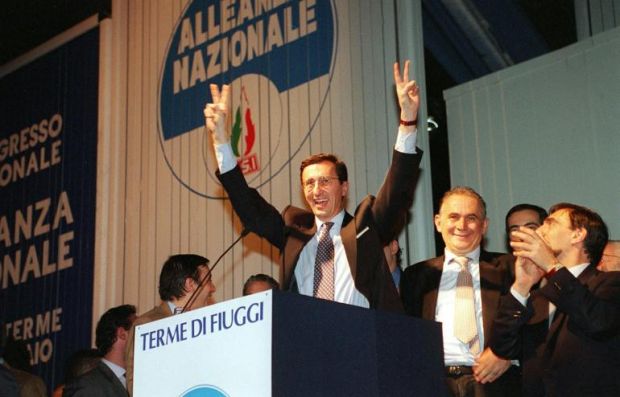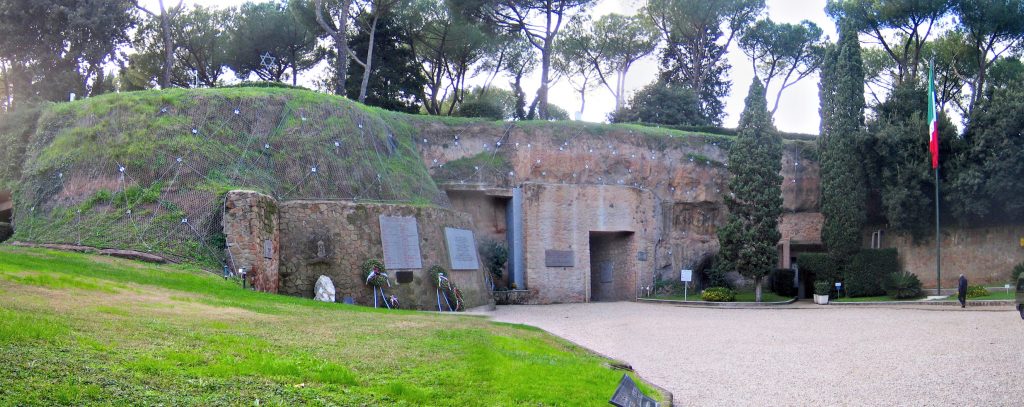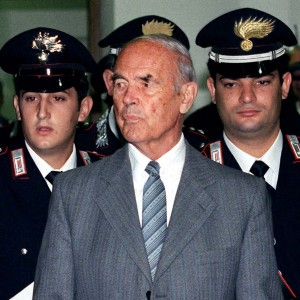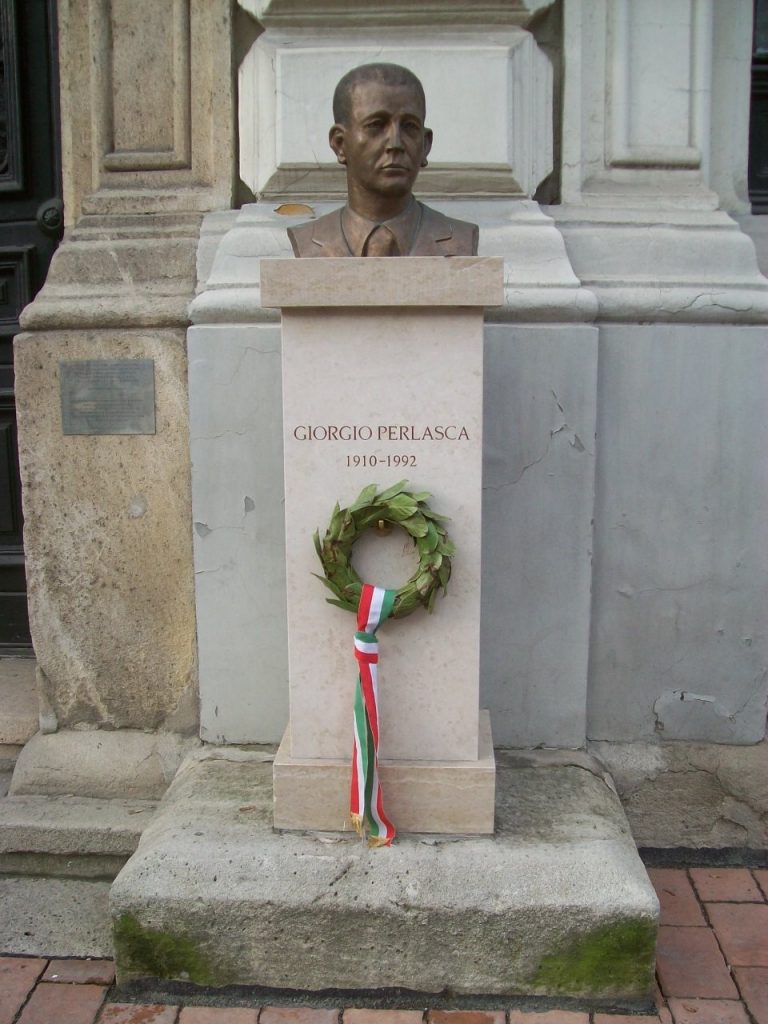Filippo Focardi, Università di Padova, Department of Political and Juridical Sciences and International Studies (SPGI)
Cover picture: National monument of the Foiba di Basovizza in Trieste | EUROM
The dramatic political changes in Europe since 1989, with the fall of the Berlin Wall, the breakup of the Soviet Union and the disintegration of Soviet control over Central and Eastern Europe, had a significant impact on Italy. These changes ushered in a phase of political transformation, which has since triggered a fierce struggle played out in the field of collective memory. Today, thirty years later, the reference points of this public memory have been radically modified, with the crisis of the tradition of anti-Fascism and the Resistance, and the rise of two new narratives: the memory of the Holocaust, and anti-totalitarianism. The latter condemns the crimes of both Nazism and Communism and places them on the same level.
To evaluate the dynamic and the results of this process of change, we need to recall briefly the background to the creation of Italy’s collective memory in the long earlier period, from 1945 to 1989. After the end of the Second World War, Italy, like other European countries that had endured the Nazi aggression, had built a national collective memory based on two fundamental pillars: on the one hand, the almost exclusive attribution of guilt for the suffering and the crimes committed during the war to Germany and the Germans, playing down the country’s own responsibility in the affairs of the Axis; and on the other, the exaltation of the myth of the Italian Resistance as a struggle which engaged the entire population against the Nazi-Fascist oppressor. The merits of the “good Italians” were placed in stark contrast to the faults of the “bad Germans”, who in reality had been allies of the Italian Fascists for three years. By the will of all the National Liberation Committee parties, from the Liberals to the Communists, who had led the struggle against Germany and the Republic of Salò created by Mussolini in September 1943, anti-Fascism and the Resistance movement became icons of the new democratic Republic and of the political multi-party system born after the fall of Fascism.
This collective memory, based on the acclamation of the merits of the Italian Resistance after 1943 and on the glossing over of Italian guilt for the war of aggression fought alongside Hitler from 1940 to 1943, had suffered serious repercussions during the years of the Cold War. The most important perhaps was the questioning of the democratic legitimacy of the Italian Communist Party (PCI), one of the protagonists of the Resistance and one of the main signatories of the constitutional pact; for example, the Catholics and liberals repeatedly accused the PCI of being “pawns” of Communist totalitarianism led by Moscow. Nevertheless, the general framework of the national memory anchored in the Resistance was never doubted; in fact, it was re-launched in the 1970s as a common heritage encompassing all the democratic and anti-fascist parties in the face of the dual challenge posed to the institutions of the Republic by the terrorism of the extreme left and extreme right.
The period known as the “Second Cold War” in the late 1970s saw the reactivation in the Italian public debate of accusations against the Communists for having monopolized the Resistance. The situation would change dramatically with the political upheavals of the early 1990s.

Gianfranco Fini during the closing of the Fiuggi Congress in January, 1995 | Wikimedia Commons 
Silvio Berlusconi during a meeting in March 6, 2008 | Lorenza e Vincenzo Iaconianni via Wikimedia Commons
Since German reunification, Italy has probably been the Western European country most affected by the collapse of the Soviet Union and the disintegration of the international system of the Cold War. The transformation of the Communist Party in 1991 into a new political entity, the Democratic Left Party, was followed by a profound crisis of the entire system between 1992 and 1994, which imploded after the huge corruption scandal known as Tangentopoli, brought to light and fought by the judiciary. Therefore, in the early 1990s all the parties that had created the constitutional pact either found their influence severely reduced or disappeared completely: first the Christian Democrats and the PCI, marked by divisions and name changes, then the Socialist Party, the Liberal Party, the Social Democrats and the Republican Party. At the same time, new political movements with no roots in the anti-Fascist tradition gained prominence and some consensus. This was the case of Umberto Bossi’s Northern League and Silvio Berlusconi’s Forza Italia, and of the old Italian Social Movement (MSI), the major Western European neo-Fascist party, now rebranded as Alleanza Nazionale (AN). The MSI-AN was especially a party with historical and cultural roots diametrically opposed to the heritage of anti-Fascism and the Resistance. Following a new electoral law in August 1993, the change from the proportional system centred on the constitutionalist parties to a majority system that favoured a bipolar arrangement, with one pole dominated by forces alien or even opposed to anti-Fascism, triggered a fierce confrontation that was based on an unprecedented use of history for political purposes.
One of the main factors behind the struggle for memory in the country was the need of the centre-right to legitimize Gianfranco Fini’s MSI-AN as a force fit to sit in government, after its electoral victory under Berlusconi in April 1994.
With varying degrees of conviction, all the parties in the governing coalition converged on a course of action aimed at neutralizing anti-Fascism as a factor of political legitimization and replacing it with anti-totalitarianism as the new point of reference. Anti-Fascism and the memory of the Resistance were depicted as politically obsolete and even dangerous ideals for Italy’s “new Republic”, a country in need of a somewhat “patriotic” renewal. From this point of view, the Italian case bears similarities to the processes in Central and Eastern Europe which, at roughly the same time, erased the previous memorial structure based on the cult of the Resistance and on the role played by the Communists and built new memories that cultivated the traditions and values of the homeland.
The traditional criticism of the Resistance, described as being a “fratricidal civil war” sought by the Communists, quickly led to the demand for an alternative public and institutional memory. For this purpose, the right-wing called for “pacification” between Fascists and anti-Fascists with the aim of creating a new “shared memory”. A traditional demand of the far-right MSI, notably the idea of national “pacification” was invoked with a rhetorical emphasis on the recognition of the “good faith” and “ethical patriotism” of the young Italians (benevolently called “the boys of Salò”) who, after 8 September 1943 had taken sides with Mussolini for the “defense of the nation’s honour”. Underlying the repeated call for the construction of a “shared” or “reconciled memory” independent from the Fascist/anti-Fascist dichotomy was an attempt of the right to achieve “parity” between the parties in the name of patriotism that did not make distinctions. Proof of this is found in the draft laws equating the fighters of Salò with the Partisans, and the explicit proposal, also advanced in Parliament, to abolish the national holiday of 25 April (the day of liberation from Fascism and of the victory of the Resistance) and to replace it with a date with an anti-totalitarian significance. The date proposed was 18 April 1948, the day when the Christian Democrats led by De Gasperi defeated the coalition of the Communists and Socialists in the Marxist-inspired Popular Front. Strongly supported by the Berlusconi governments, these measures were never passed but they represent relevant examples of the intentions of the new Italian right in relation to politics of memory). Until 2009, Berlusconi himself was conspicuously absent from the official commemorations on 25 April, conducting a constant anti-Communist polemic (for example, by widely publicizing the Black Book of Communism) and on several occasions, he has presented himself as a spokesman for a sugar-coated vision of Fascism, in line with a widespread popular feeling.

In an interview with the English newspaper “The Spectator” in August 2003, Berlusconi stated that “Fascism was a benign dictatorship” that sent people on holiday to confine them”. in January 2013, on the occasion of the commemorations of the Holocaust, Berlusconi mentioned Mussolini’s alleged merits, saying that his only fault was to have been an improvised ally of Hitler and to have passed the racial laws.
Gianfranco Fini, the last secretary of the MSI party and instigator of its transformation into Alleanza Nazionale, an alleged post-ideological and anti-totalitarian modern liberal force, played a major role in the politics of memory promoted by the right-wing elites. At the time, this effort carried little credibility seeing that in an interview with an Italian newspaper in April 1994, Fini called Mussolini “the greatest statesman of the century”.
Moreover, after introducing the category of anti-totalitarianism as a point of reference, the post-Fascist right considered the German Nazi regime and the Communist dictatorships to be totalitarian, but not, according to historian Renzo De Felice, Italian Fascism. For a final reckoning with the experience of the Fascist regime, it seemed enough to condemn only the most flagrant link between the dictatorship of Mussolini and Nazi totalitarianism: that is, anti-Semitism and the persecution of the Jews.
So it was in relation to the memory of the Holocaust that Fini’s journey towards democratic legitimization began at the end of the 1990s. After a visit to Auschwitz in 1999, and after the establishment of the second Berlusconi government in 2001, as Deputy Prime Minister he gave an interview in September 2002 to the Israeli newspaper Ha’retz in which he asked for forgiveness for the racial laws; finally, on his trip to Israel in November 2003, he visited Yad Vashem in Jerusalem and condemned the “infamous racial laws of 1938 enacted by Fascism”, calling them an “absolute evil” for their co-responsibility in the Holocaust.
Fini’s stance on the fascist anti-Semitism led to a rupture with the more intransigent wing of the party, starting with the Duce’s granddaughter Alessandra Mussolini. At the political level this change contributed to the “democratic legitimization” of the leader of AN. He was named Minister of Foreign Affairs in 2004 and President of the Chamber in April 2008. Yet, at the level of public debate this has indeed worked as a sort of “purification rite” of Fascism; it paved the way for the rehabilitation of Mussolini’s regime by the media during the 1980s under the influence of the revisionist currents. Considering Fascist anti-Semitism as the only “stain” to be erased, many members of the post-MSI right thought they had now, so to speak, a “freehand” for promoting Fascism’s alleged historical merits – from the modernization of the country to the fight against Mafia – obscuring or even denying the dimension of violence and coercion of internal opponents and other peoples invaded in the country’s forays abroad.
It is not surprising that centre-right local administrations in Italian cities promoted the renaming of streets, squares or public buildings to honour a large number of Fascist figures, and the “martyrs of the foibe”: Italians captured and killed by Tito’s Communists in the regions of Venice-Giulia and Istria after the Italian armistice in September 1943, and especially after the end of the war in May 1945, when Yugoslavia had annexationist designs on what at that time was Italian territory. The name foibe comes from the name of the sinkholes where the bodies of the victims were thrown.
The memory of the foibe, with its strong anti-Communist imprint, has become one of the strongest icons of all the Italian right, including the League of Bossi and Salvini. In March 2004, on the proposal of AN and with the support of all parties except the extreme left, the Parliament approved a law that introduced a “Day of Remembrance” in the civil calendar in memory of the victims of the foibe and of the 250 thousand Italians expelled from Istria and Dalmatia.
Always a key element in the memory of the war cultivated by the neo-Fascist right, the martyrs of the foibe have thus become part of the national public memory. There can be no doubt that it was important to raise awareness about these dramatic events, but it is also true that it was done without any critical reflection. Indeed, the neo-Fascist narrative of the immediate post-war period which denounced the foibe as the fruit of Communist Yugoslav expansionism and hatred of Italy has now been revived, without including any historical context: that is to say, without any reference to the twenty-year oppression of the Slovenian and Croatian populations by Italian Fascists in the territories annexed to Italy after the First World War, or to the Italian occupation of Yugoslavia in 1941-43, which was stained by serious war crimes.
The institutionalization of the Day of Remembrance has provided the right with a very effective channel to spread its version of the phenomenon of the foibe, decrying it as an act of “genocide” committed against unarmed victims – it became, in other words, a campaign of “ethnic cleansing” against Italians hunted down for no other reason than their nationality. This supported a process of equating Communist violence with the German one, to the point that the rightist mass-media are currently labelling the foibe as the “Italian Shoah”.
How did the forces traditionally linked to the different cultures of anti-Fascism react? Three distinct attitudes can be identified: full-blown opposition, “change of allegiance”, and a willingness to compromise. As a reaction to the new offensive of the right-wing, an energetic movement of opposition emerged in defence of the anti-Fascist foundations of Italian democracy. The defence of the memory of the Resistance fuelled a vigorous protest movement at the street level. The celebrations of 25 April became an occasion for great popular demonstrations, starting with the 1994 protest in Milan against the newly elected Berlusconi government. This movement demonstrated the existence of a social memory of the Resistance with very deep and vital roots, already palpable in the 1960s and 1970s and which now re-emerged to face the challenge posed by the new right of Berlusconi. The media mogul’s political enterprise was actually seen by many sectors of the opposition as a threat to democracy. In this sense, anti-fascism can be rightly seen as a mobilizing “tool” to defend the whole overall democratic system.
The late 1990s saw another mobilization of public opinion with the resumption of judicial proceedings against Nazi war criminals, starting with the trial of the former SS captain Erich Priebke in Rome, followed by some twenty trials (in absentia) against the men responsible for the worst massacres of Italians carried out by the Nazis after September 1943.

Fosse Ardeatine, Roma | Anthony Majanlahti via Wikimedia Commons 
Erich Priebke process, 1996 | Unknown author, via Wikimedia Commons
The attention to the memory of the massacres promoted the re-introduction of the traditional anti-Fascist narrative focused on the representation of Italians as victims of Nazi-Fascism. This representation had favoured, albeit indirectly, the assuaging of Italian guilt and the affirmation of the self-absolving image of “good Italians”. However, this comfortable alibi started being questioned in the second half of the 1990s when a new series of studies brought some of the darkest pages of Fascist Italy to the attention of public opinion, including colonial violence, the persecution of Jewish rights and lives, and the crimes committed in the territories occupied by the regime during the Second World War.
Shaken by the investigations of historians’s new analyses, in 1996 the myth of the “good Italian” was officially rejected by the Ministry of Defence which acknowledged the use of chemical weapons by the Italians during the Ethiopian campaign – a reality instead long denied by the conservative press despite the evidence presented by scholars. The criticism of the stereotype of an Italian colonialism “with a human face” was led by the historian and journalist Angelo Del Boca, who inspired the 2006 legislative proposal by the Italian Communist Party to dedicate a day of remembrance for the victims of Italian Colonialism. A little later, another draft law was proposed by the Communists with the aim of dedicating a day to all the victims of Fascism, but the electoral defeat of the radical left in the 2008 elections put an end to the plan.
Efforts made in defence of the anti-Fascist public memory and the attempts to reinforce it has managed to contain the anti-Fascist crisis but have not reversed it, failing to construct a “regenerating reading of the Resistance paradigm”.
This process was also made evident by numerous “migrations”, not only by politicians, intellectuals and journalists of the old PSI but also by the former members of the PCI and extra-parliamentary left-wingers who ended up on the right-wing side of the political spectrum – especially in Forza Italia, where they played an active role in the revisionist battle on memory. The famous left-leaning journalist Giampaolo Pansa was, without any doubt, a protagonist of this battle. He did not choose to be politically tight to the right, but with his books, which sold hundreds of thousands of copies, he was one of the main architects of the controversy against the Resistance, which was conducted in an increasingly acrimonious atmosphere.
Alongside the two opposite poles of opposition and “betrayal”, the tendency to revise the anti-Fascist memory has also appeared on the left, in the form of a willingness to compromise. Support for an agreement with the right was manifested above all in the former Communist party, which first became the Democratic Party of the Left (PDS), then the Democrats of the Left (DS), and finally merged with the Catholics of La Margherita to form the Democratic Party (PD). With this transition, the post-Communist leadership of the PCI was particularly responsive to the invitation issued by the right-wing with regard to the construction of a “shared memory”. In this dialogue the AN was the privileged point of contact; each side sought recognition of its legitimacy from the other in order to cement the new bipolar political structure born in the 1990s in which these two parties took centre stage after being excluded from government under the First Republic.
One of the leading promoters of the move to reconcile the “opposing memories” was the ex-magistrate and member of parliament for the PDS, Luciano Violante, who, as President of the Chamber of Deputies, engaged in close dialogue with Fini on the subjects of the foibe and the “boys of Salò”. The compromise between the two political leaders was cemented on the controversial memory of the foibe, as evidenced by the DS’s support for the establishment of the Day of Remembrance in 2004 and the decision of many left-wing local councils to name streets and squares after the martyrs. Rather than proposing its “critical” version of this memory, the left has accepted the strong nationalist version favoured by the right-wing describing the Italians of the foibe as the “innocent victims” of a frantic “ethnic cleansing” and thus absolving the Fascist regime of its guilt.
The search for a political compromise also underpinned the legislation of July 2000, which introduced the Day of Remembrance in memory of the Holocaust on 27 January. This is the most important of the commemorations recently established in the country. Promoted by the left to remember “the Italian persecution of Jewish citizens” and other victims of deportation, the law never uses the word “Fascism”. Among its purposes, it includes the recognition of the aid given to the Jews by the Italians of all political persuasions.
The commemoration of those who helped the victims of persecution was also one of the aims of the declaration of the 2000 Stockholm International Forum on the Holocaust. In Italy, however, the commemoration has had significant consequences. Among the many tributes held since January 2001 dedicated to the memory of the Jews persecuted by the Nazis and the Fascists and of the deportation of Italian military and politicians to German concentration camps, there is a clear tendency (especially on the right) to favour the celebration of acts of solidarity and aid made by Italians.
One figure highlighted in particular was Giorgio Perlasca, a former Fascist volunteer in the Spanish Civil War, who claimed to be the Spanish consul in Budapest in 1944 and managed to save thousands of people. For this act, he was awarded the “Righteous among the nations” honour. The recognition of Perlasca and other “saviours of Jews” has thus revived the image of the “good Italians” among public opinion. The danger of this policy is that it provides a comfortable smokescreen behind which the national conscience can hide – and thus avoid coming terms with the country’s involvement in the persecution of the Jews.

In the Italian “war of memory” – with all its battles, its ceasefires, and its compromises – a crucial role was played by the Presidents of the Republic, Oscar Luigi Scalfaro (1992-1999), Carlo Azeglio Ciampi (1999-2006), Giorgio Napolitano (2006-2015), and lastly Sergio Mattarella, the present incumbent. Ciampi and Napolitano, in particular, chose memory as a privileged area of intervention to hold together a country which had long been divided by the bitter political clash between centre-right and centre-left under Berlusconi and whose national cohesion was under threat from the separatist Northern League. Both Ciampi and Napolitano sought to construct an “all-encompassing memory” which included new elements that were not part of the earlier anti-fascist narrative such as the memory of the foibe, the victims of Allied bombing of Italian cities, and the rapes committed by the French expeditionary force in Italy. But, above all, they revived and defended the memory of the Resistance by protecting and defending it against the revisionist campaign.
Thanks to the presidency of the republic, the demand that the boys of Salò should be placed on the same footing as the Partisans has been rejected. The same happened with the proposal to abolish 25 April as a national holiday. Ciampi and Napolitano placed the recognition of the Resistance at the centre of the institutional memory interpreting it in a neo-patriotic fashion and as a struggle for national liberation resulting from the union between people and the army. Both presidents limited the explicit references to anti-Fascism and supported the idea of the Resistance for the armed forces who remained loyal to the king and stood up to the Germans. It is no coincidence that the Greek island of Kefalonia, the scene of the Wehrmacht’s worst massacre of Italian soldiers, has become a key site of memory. The Presidents of the Republic have underlined the bond that unites the Risorgimento (the birth of the national state in the nineteenth century) to the First World War and to the Resistance, which is traditionally described as “the second Risorgimento”. And they have consistently stressed the European significance of the Resistance, identifying the foundation of today’s united Europe in the struggle against Nazism and Fascism waged by Italy and the other populations of the continent. From this European perspective, we should also underline President Napolitano’s attempts since 2010 to transform the foibe from a nationalist memory into a memory of European reconciliation between Italy, Slovenia, and Croatia, based on the mutual recognition of wrongs that the parties have historically inflicted on each other and on a fruitful future collaboration inside the European Union. This policy has helped to avert a potentially dangerous political confrontation between Italy and its eastern neighbours, marked over the years by diplomatic crises and by the neo-irredentist positions of the Italian right. Italian nationalists were keen to redefine the territorial agreements signed by Italy and Yugoslavia in 1975, claiming that the dissolution of the Yugoslav Federation rendered them invalid. Even the Presidents of the German Republic’s numerous visits made in Italy to the sites of the Nazi massacres were a clear sign of a process of (“bilateral”) reconciliation in the name of their common EU membership.

In other words, Italy since the 1990s represents a particularly interesting case with reference to the changes in public narratives and cultures of memory. The new coordinates of European memory promoted by the EU institutions in Brussels – the memory of the Shoah and the anti-totalitarian paradigm – have gained considerable ground inside the Italian public opinion. The memory of the Resistance, the bedrock of the First Republic, came under great pressure from two sides: competition from the Shoah on the one hand, and the antagonistic memory of the foibe on the other. Thanks to the steadfastness of the country’s presidents, the memory of the Resistance has not been undermined or replaced and has remained a fundamental pillar in the national institutional memory. The celebration of the 70th anniversary of Italy’s liberation in 2015 showed, if anything, some signs that this memory is being recovered, thanks to the committed support of the new president Sergio Mattarella. In such context, an analogy can be noticed with the relaunch of the memory of the Resistance that took place in France, where in July 2013 the Assemblée Nationale voted to establish a National Resistance Day.
All the main contemporary Italian public memories (the Resistance, the Shoah, the foibe) remain linked to the experience of the Second World War. With the demise of the parties that created the now disappeared First Republic, their political cultures, rooted in anti-Fascism, faded away. Now Italians citizens tend to collectively identify themselves as victims – either at the hands of the Nazis or at the hands of the Yugoslavs. At the same time, they identify themselves as the “righteous” and cultivate the memory of the “good Italians” who helped the Jews. A more conscious memory, one more aware of the events of the past and better equipped to deal with the dark pages of the history of a country that was the cradle of Fascism in Europe, is still struggling to make its way.
